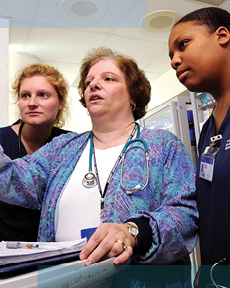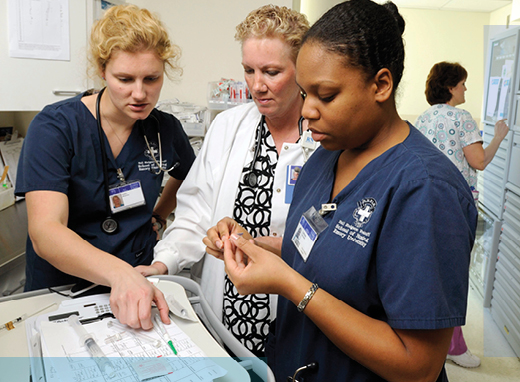Becoming a Real Nurse
Kelly Brewer (center, shown here with Emory student nurses Whitney Winston and Kaitlin Ahienius) coordinates teaching in the Dedicated Education Unit.
by Sylvia Wrobel, photography by Jack Kearse
A complex health care system awaits nursing students the day they graduate, and veteran nurses are helping them get ready to handle the real world.
Early every Tuesday for 15 weeks, Whitney Winston and Kaitlin Ahienius head to unit 10-E in Emory University Hospital (EUH). On each of those Tuesdays, the Emory nursing students work alongside 30-year seasoned nurse Corinne Slack throughout a 12-hour shift. They say the long shift—typical for nurses—marked their first acclimation to real-world nursing.
They are there in the morning when the night nurse gives Slack an update at patients’ bedsides. They squeeze in with their instructor in the small medication room, reviewing each patient’s updated laboratory results and medication orders. Although Winston and Ahienius lack the privilege to access the locked medicine cabinets, Slack hands them the drugs, which they check against orders on a computer, then watch their teacher double-check their work. Pushing a cart loaded with medicines and the ubiquitous computer, they next follow Slack to the first patient’s room, where her name as nurse and theirs as students are printed on a white board at the foot of the bed so that the patient and family members can identify them.
Traditionally, groups of nursing students have trailed a nursing professor through different clinical units to get their first interactions with patients, to draw blood or give injections on a person rather than a mannequin, to see how quickly emergencies occur and staff nurses respond. But what Winston and Ahienius are experiencing is total immersion in a dedicated education unit (DEU), where they begin to understand the pace, choreography, and culture of a unit in a complex, tertiary care hospital.
Susan Grant, chief nursing officer for Emory Healthcare, says even the best-prepared new nurses can take months to become comfortable and confident—time health care can ill afford in an era of shortages, both of staff nurses and nursing faculty to train more. That’s one reason Emory Healthcare was eager to be a part of a joint plan with Emory’s Nell Hodgson Woodruff School of Nursing to offer a faster-track, more immersive, staff nurse-centered clinical rotation to junior and senior nursing students.
Emory launched the first two DEUs in 2009—at EUH on 10-E, where patients are recovering from gastrointestinal surgery and at EUH Midtown on a floor for patients with a range of complex medical and postsurgical conditions. A DEU in Midtown’s women’s services soon followed, and others are now in the works.
Although DEU programs vary widely, they usually share a strong partnership between nursing schools and hospitals, experienced staff nurses who serve as the primary clinical instructors, and a commitment of the nurses on these units to help students learn what it means to be one of them.

Veteran nurse Corinne Slack (center) reviews medication instructions with nursing students on 10E in Emory University Hospital—where they experience the real world of a busy, clinical unit at a tertiary care center. |
Teaching students and the teachers
As coordinator of Emory’s DEU program, Kelly Brewer meets with undergraduate students weekly or whenever they need answers or context. She grades their assignments and stays with the students—whom she affectionately calls “my chicks”—during the long days they spend on the DEU clinical rotation.
Brewer also prepares and supports the staff nurses who serve as the students’ primary clinical instructors. Many DEU instructors already have experience as preceptors who have taught the ropes to new nurses. But having primary responsibility for undergraduates requires a different level of responsibility: meeting educational objectives, evaluating work and providing feedback, motivating students to keep performing and progressing, encouraging them when they break down, and correcting them when necessary.
The payoff for students makes the effort worth it. Because DEU students work in pairs and do not have to wait for a professor to do a procedure among a larger group, they say they sometimes do more real nursing in one day than they did in total during three regular rotations.
As a DEU clinical instructor, Slack continually evaluates her students’ strengths and weaknesses, teaching them new skills when they are ready. Today, for example, her students carefully change a surgical dressing. Good job, says the young patient, then asks Slack if she can walk down the hall later that day. Yes, is the answer, and Whitney and Kaitlin will come help you.
Of course, if patients prefer not to have students involved in their care, they can opt out. Few do. Most, like a middle-aged man with a belly swollen from his surgery, seem to enjoy participating in the program. “They were nervous at first,” he jokingly says, “but I started teaching them right away.” Under Slack’s watchful eye, the students ask the man to rate his pain. They take his vital signs, give him a scheduled injection, and log their actions into the computer. Slack rechecks everything and nods almost imperceptibly—both at the skill of the injection and the “confident demeanor” she considers to be a vital part of learning to be a nurse.
Students also must learn to prioritize, says Slack. When a crisis occurs on the unit—a bleed-out or a cardiopulmonary arrest—the students see prioritization in action, staying out of the way but later getting explanations from Slack, Brewer, and other nurses. They review the events of the day over a meal with Brewer in the hospital cafeteria and share entries from their clinical journals.
Between patients, Slack talks informally to her young charges in the conference room about how to deal with problems she and her colleagues have faced. She also tells her young charges that patients know their bodies best and will be their biggest allies and partners in care.
Where quality and teaching meet
As health care becomes more complex, staff nurses increasingly are called on to fill expanding roles, master more technology and information management systems, and collaborate and coordinate care across growing teams of health professionals. That’s a lot of responsibility. When Grant first proposed the DEU initiative to nursing managers and staff nurses in Emory Healthcare, she half expected a veiled protest: “Oh goody, something new again.” Instead, she got enthusiasm for more teaching—as long as it didn’t diminish safety and quality of care for patients.
That was three years ago. Far from diminishing patient care, these units get extra staffing to assure teaching time doesn’t take away from patient time. Quality is foremost in the DEU, where students are taught that the daily quality-improvement plan is as important as the care plan.
“I know there will be new things when we start practice,” says Winston, “but I don’t think they will be such a shock.” “And now that I’ve been part of this team,” adds Ahienius, “I feel more confident, knowing there will always be nurses to help me like the ones on 10-E help us and each other.”-EH



